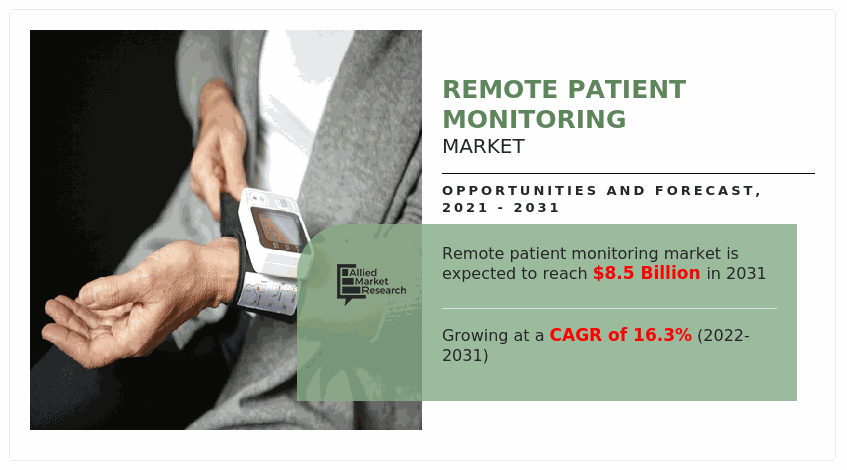
Remote Patient Monitoring (RPM) Market: A Game-Changer in Digital Healthcare

Remote Patient Monitoring (RPM) Market-----
PORTLAND, OR, UNITED STATES, February 6, 2025 /EINPresswire.com/ -- The global remote patient monitoring (RPM) market is experiencing exponential growth, fueled by technological innovations, increasing healthcare demands, and the rising prevalence of chronic diseases. Valued at $1.9 billion in 2021, the market is projected to reach $8.5 billion by 2031, growing at a CAGR of 16.3% from 2022 to 2031. This rapid expansion highlights the crucial role RPM plays in modern healthcare by providing cost-effective, efficient, and patient-centric solutions.
Get a Sample Copy of this Report: https://www.alliedmarketresearch.com/request-sample/1727
Understanding Remote Patient Monitoring
RPM involves collecting and transmitting health-related data from patients to healthcare providers using digital technologies. These real-time insights help manage chronic conditions, improve post-operative care, and monitor elderly patients without frequent hospital visits, ultimately reducing healthcare costs.
Key Drivers of Market Growth
Several factors are accelerating the adoption of RPM solutions:
• Aging Population: The global elderly population (aged 65+) is projected to grow from 703 million in 2020 to 1.5 billion by 2050, increasing the need for continuous health monitoring.
• Rising Chronic Diseases: The growing incidence of diabetes, hypertension, and COPD is driving demand for RPM solutions.
• Technological Innovations: Advances in wearable devices, AI-driven analytics, and telemedicine are enhancing RPM capabilities.
• Cost Efficiency: RPM reduces hospital readmissions, with studies showing a 76% decrease in readmission rates and $370 million in cost savings reported by the Center for Medicare and Medicaid Services.
• Post-Pandemic Acceleration: The COVID-19 pandemic reinforced the need for remote healthcare solutions, leading to widespread adoption.
Market Segmentation
The RPM market is segmented based on condition type, component, and region:
By Condition Type
• Congestive Heart Failure: Accounted for $916.75 million in revenue (2021) due to the rising burden of heart diseases.
• Diabetes: Increasing global prevalence is driving demand for RPM solutions.
• COPD: RPM is crucial for managing respiratory diseases.
• Mental Health: Gaining traction as mental well-being becomes a priority.
• Others: Includes hypertension, post-operative care, and other chronic conditions.
By Component Type
• Devices: Represented $1,453.63 million in revenue (2021), driven by the need for home-based monitoring.
• Software: Includes data analysis platforms, telehealth integration, and patient management tools.
By Region
• North America: Dominated with $746.40 million in revenue (2021), supported by advanced healthcare infrastructure and high technology adoption.
• Europe: Growing due to increased healthcare investments and an aging population.
• Asia-Pacific: Emerging as a key market due to improving healthcare infrastructure and rising disposable incomes.
• LAMEA: Gradual adoption with significant growth potential in the coming years.
Challenges and Opportunities
Despite its promising growth, the RPM market faces challenges:
• High Initial Costs: The investment in RPM devices and software can be prohibitive for some patients and providers.
• Limited Awareness: Developing regions have lower adoption rates due to lack of awareness.
• Reimbursement Barriers: Inconsistent policies hinder market expansion.
However, advancements in AI, IoT, and 5G are creating new opportunities, making RPM more accessible and affordable.
Key Players in the RPM Market
The competitive landscape includes:
• Abbott Laboratories
• Biotronik SE & Co. KG
• Boston Scientific Inc.
• Datos Health
• General Electric
• Honeywell International
• Johnson & Johnson
• Koninklijke Philips N.V.
• Medtronic
• Nihon Kohden
These companies are investing in R&D, strategic partnerships, and AI-driven solutions to enhance their market positions.
Future Outlook: The Road Ahead
RPM is transforming global healthcare by enabling real-time patient monitoring and improving outcomes. With continuous technological evolution, the future of RPM is poised to revolutionize patient care, lower costs, and enhance accessibility. As digital health solutions gain traction, RPM will play a pivotal role in shaping a more connected and efficient healthcare ecosystem.
Key Takeaways
• The RPM market is projected to grow from $1.9 billion (2021) to $8.5 billion (2031) at a CAGR of 16.3%.
• Aging population and chronic diseases are major growth drivers.
• North America leads the market, followed by Europe and Asia-Pacific.
• Challenges include high costs and reimbursement barriers, but AI and IoT advancements offer substantial opportunities.
• Major industry players are focusing on innovation and strategic collaborations.
The shift toward remote patient monitoring is not just a trend—it is the future of healthcare, ensuring improved patient outcomes and a more efficient global health system.
Enquire Before Buying: https://www.alliedmarketresearch.com/purchase-enquiry/1727
David Correa
Allied Market Research
+ + 1 800-792-5285
email us here
Visit us on social media:
Facebook
X
LinkedIn
YouTube
Distribution channels: Business & Economy, Healthcare & Pharmaceuticals Industry
Legal Disclaimer:
EIN Presswire provides this news content "as is" without warranty of any kind. We do not accept any responsibility or liability for the accuracy, content, images, videos, licenses, completeness, legality, or reliability of the information contained in this article. If you have any complaints or copyright issues related to this article, kindly contact the author above.
Submit your press release